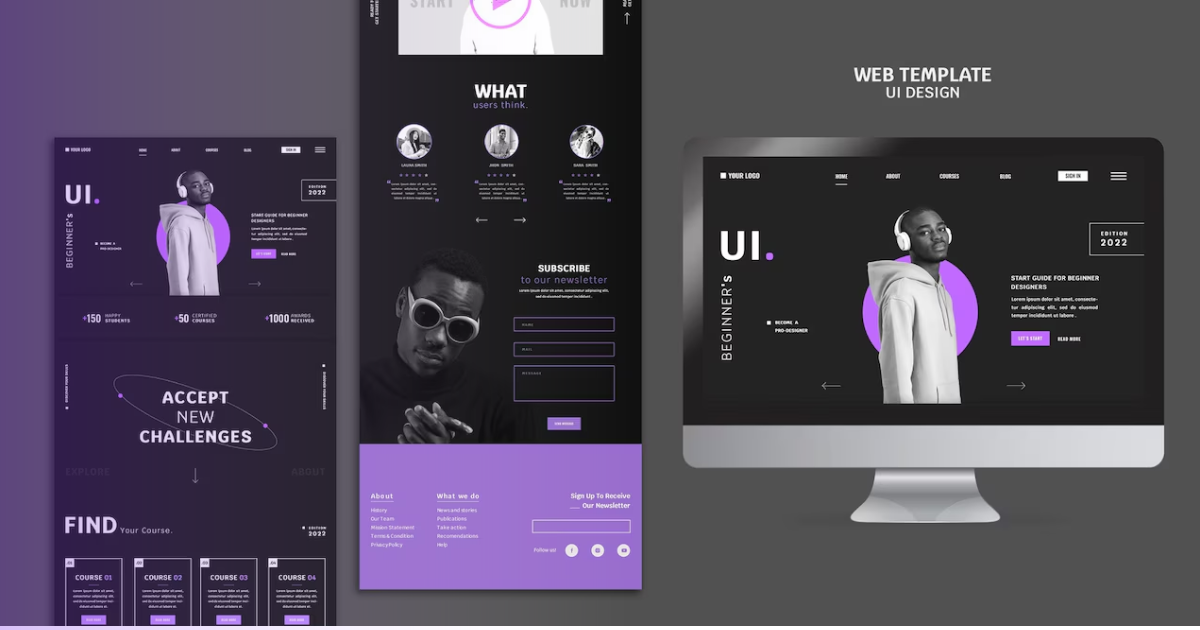Internet Advertising In South Africa: Top Strategies That Drive Traffic
Wiki Article
The Essential Aspects of Effective Internet Design: A Comprehensive Guide
Effective internet Design encompasses numerous vital elements that considerably influence user experience. It requires mindful consideration of variables such as mobile responsiveness, intuitive navigating, and visual pecking order. Each part plays a necessary role in crafting a web site that not just attracts site visitors yet additionally keeps them. Understanding these foundational facets is vital for businesses intending to boost their on-line presence. Yet, what genuinely identifies a successful site from its rivals?Understanding User Experience (UX) Design
Individual experience (UX) Design acts as the backbone of efficient website design, concentrating on exactly how customers interact with a web site. It encompasses numerous components, consisting of functionality, ease of access, and total satisfaction. A successful UX Design begins with user study, recognizing the target audience's needs and behaviors. Models and wireframes are after that established to visualize the website's framework and circulation. Seo Company Klerksdorp. Examining with genuine users offers beneficial understandings, enabling developers to improve the user interface and enhance navigation. Visual Design components, such as typography and shade plans, enhance the total visual while supporting functionality. Inevitably, effective UX Design guarantees that users can quickly accomplish their goals, fostering involvement and loyalty. By focusing on individual experience, web sites can achieve greater conversion rates and a favorable track recordSignificance of Mobile Responsiveness
As mobile phones significantly control net usage, ensuring mobile responsiveness has actually become crucial for reliable internet Design. Websites that are not enhanced for mobile can bring about an inadequate individual experience, causing higher bounce prices and lost chances. A mobile-responsive Design permits content to adapt effortlessly to numerous screen sizes, ensuring that individuals can access details conveniently, no matter the gadget they make use of. Additionally, internet search engine prioritize mobile-friendly internet sites in their positions, making responsiveness an essential aspect for exposure and website traffic. With a growing number of customers accessing the net via smart devices and tablets, services must buy mobile responsiveness to improve individual involvement, enhance brand understanding, and eventually drive conversions. Effective web Design need to focus on mobile responsiveness to continue to be competitive in today's digital landscape.Crafting Instinctive Navigating
Navigating acts as the backbone of any efficient web site, assisting visitors with web content easily. An instinctive navigating structure enhances user experience by permitting customers to find information quickly and efficiently. Clear labeling of menu things is essential; it needs to mirror the web content properly, preventing jargon that may confuse customers. Additionally, a sensible power structure is critical, making it possible for customers to recognize connections between various sections. Consistency throughout pages aids enhance assumptions, while breadcrumbs offer context and a feeling of instructions. Responsive navigating food selections that adjust to various gadgets further boost accessibility. Inevitably, the goal is to develop a seamless journey for site visitors, ensuring they can check out the website without frustration, bring about a more involved and pleased target market.Using Aesthetic Pecking Order
Aesthetic pecking order plays a critical function in website design by assisting users' interest and enhancing their experience. Reliable layout methods, together with thoughtful choices in color and typography, can greatly influence just how information is viewed and refined. Recognizing these aspects is important for producing useful and aesthetically appealing internet sites.Value of Visual Hierarchy
Effective web Design depends upon the concept of visual pecking order, which guides users with web content in a sensible and instinctive fashion. This concept is vital for enhancing user experience, as it helps prioritize info and routes interest to necessary components. By establishing a clear power structure, web designers can assure that users easily identify key messages, phones call to activity, and navigating choices. A well-structured visual power structure reduces cognitive load, permitting users to process information successfully. Furthermore, it fosters engagement by developing an enticing design that welcomes expedition. Inevitably, comprehending the importance of visual power structure is crucial for any type of internet developer aiming to develop effective and straightforward websites that efficiently interact their desired messages.
Techniques for Reliable Format
A well-organized layout acts as the foundation of any type of successful web Design, permitting customers to effortlessly navigate via material. Efficient techniques consist of grid systems, which give a structured structure for straightening aspects, guaranteeing uniformity and balance. In addition, utilizing whitespace strategically can boost focus on key locations, lowering aesthetic clutter and leading individual focus. Prioritizing web content through dimension and placement better highlights essential details, while different aspects can create a clear aesthetic pecking order. Executing responsive Design techniques assurances formats adjust flawlessly across devices, keeping use. Finally, incorporating user-friendly navigation aids, such as buttons and menus, enhances user experience, making it less complicated for visitors to discover pertinent information quickly. Together, these methods create the structure of an effective web design.Shade and Typography Choices
While shade and typography choices may look like basic Design components, they play a necessary duty in establishing visual hierarchy on a web site (Web Design South Africa). Color can assist customers' attention, differentiate sections, and communicate brand name identity. By strategically making use of contrasting colors, designers can highlight crucial phone call to activity, guaranteeing they stand apart. Typography, on the various other hand, influences readability and individual involvement. An appropriate typeface can share tone and individuality, while differing font sizes and weights can create a clear framework. As an example, larger, bolder headings draw attention, while smaller sized body message supplies in-depth information. Together, effective shade and typography options create a natural visual experience, leading users via the material effortlessly and boosting general usabilityPicking the Right Shade Scheme
How does one pick the suitable color scheme for an internet site? Selecting the best shade plan is vital for boosting individual experience and conveying the brand name's message. Designers need to begin by considering the target audience and the feelings that different shades evoke. Blue commonly represents trust, while red can develop seriousness. It is necessary to limit the scheme to a couple of corresponding colors to preserve aesthetic consistency and prevent frustrating users. Using devices like color wheel applications can help in picking colors that work well with each other. Additionally, developers must ensure that there is enough contrast between message and background colors for readability. Inevitably, a well-thought-out color design can significantly affect a website's effectiveness and individual involvement.Incorporating Engaging Material

Involving content is necessary for maintaining the attention and capturing of internet site visitors. It works as a bridge between the site's Design and the individual's experience, cultivating much deeper connections. Effective material usually includes a mix of helpful write-ups, captivating visuals, and interactive aspects that urge customer participation. By utilizing narration methods, internet sites can stimulate emotions, making the material extra unforgettable and relatable. Additionally, integrating user-generated material, such as evaluations or testimonies, boosts trustworthiness and develops depend on with the target market. Clear calls-to-action overview individuals towards preferred results, ensuring they stay engaged. Generally, a calculated strategy to material advancement not only enhances user experience but also drives conversions, making it a vital element of efficient web Design.
Optimizing for Speed and Efficiency
Maximizing for rate and performance is vital for improving user experience on a website. Strategies such as photo compression, minifying CSS and JavaScript, and leveraging internet browser caching can substantially lower packing times - Internet Advertising In South Africa. These techniques not only boost performance however also add to much better online search engine rankingsImage Compression Strategies

Minifying CSS and JavaScript
Although lots of web designers concentrate on picture optimization, minifying CSS and JavaScript is just as necessary for enhancing internet site speed and efficiency. Minification entails removing unnecessary characters from code, such as whitespace, comments, and format, without affecting its performance. This procedure results in smaller data dimensions, which results in quicker filling times and improved individual experience. By reducing the amount of information moved between the customer and the server, minification helps lessen transmission capacity usage and improves general website efficiency. Additionally, online search engine prefer faster sites, which can enhance search positions. Implementing tools and automated processes for minifying these manuscripts can simplify web advancement and upkeep, ensuring that performance stays a concern throughout the lifecycle of an internet site.Leveraging Browser Caching
Leveraging browser caching considerably boosts website speed and performance by keeping often accessed sources in your area on a customer's tool. This practice reduces the requirement for repeated demands to the web server, substantially decreasing loading times for returning visitors. By using HTTP headers, internet developers can specify caching policies for numerous sources, such as manuscripts, stylesheets, and photos. Appropriately carried out caching methods enable users to experience faster web page tons, leading to improved user satisfaction and engagement. In addition, online search engine prefer web sites with enhanced performance, possibly improving search rankings. Routinely handling and reviewing cache setups ensures that users obtain updated content while still profiting from the performance of cached resources. Finally, reliable web browser caching is a necessary component of maximizing web efficiency.Often Asked Inquiries
Exactly how Do I Choose the Right Internet Design Tools?

Picking the best website design tools includes evaluating task demands, understanding customer needs, and reviewing numerous software functions. Compatibility, convenience of usage, and neighborhood support are additionally essential factors to consider for effective Design outcomes.
What Prevail Internet Design Blunders to Stay Clear Of?
Usual website design errors to prevent consist of chaotic layouts, bad navigating, poor mobile responsiveness, sluggish filling times, and overlooking individual experience. Reliable layouts focus on accessibility, functionality, and simplicity to involve customers and boost complete satisfaction.Exactly How Can I Determine My Web site's Success?
To gauge a website's success, one may evaluate metrics such as web traffic, conversion rates, individual interaction, and bounce prices. Making use of tools like Google Analytics can supply valuable understandings for recurring optimization and improvement strategies.What Function Does SEO Play in Website Design?
SEO substantially influences web Design by making sure that internet sites are structured for internet search engine visibility. This consists of maximizing website rate, mobile responsiveness, and content quality, inevitably boosting customer experience and driving organic web traffic.Just how Frequently Should I Update My Site Design?
The frequency of site Design updates depends on sector patterns, customer comments, and technological innovations. Normally, a refresh every 2-3 years is recommended, ensuring the website remains pertinent and aligned with existing requirements and user assumptions.User experience (UX) Design offers as the foundation of effective internet Design, focusing on exactly how customers engage with a website. With an expanding number of customers accessing the web using tablet computers and smartphones, services should spend in mobile responsiveness to boost user interaction, boost brand assumption, and eventually drive conversions. An instinctive navigating framework enhances individual experience by permitting users to discover information rapidly and successfully. Effectively applied caching techniques allow customers to experience faster web page loads, resulting in boosted individual contentment and engagement. The frequency of internet site Design updates depends on market trends, customer responses, and technical improvements.
Report this wiki page